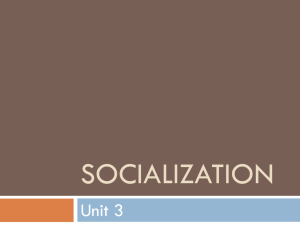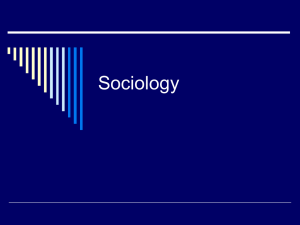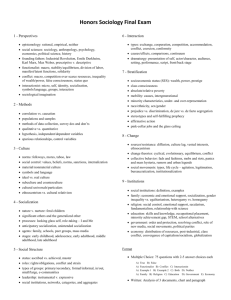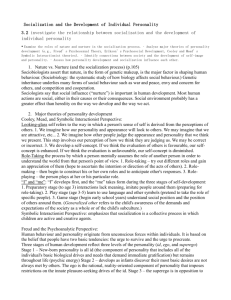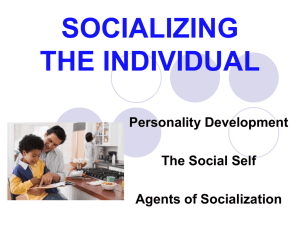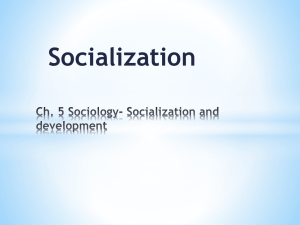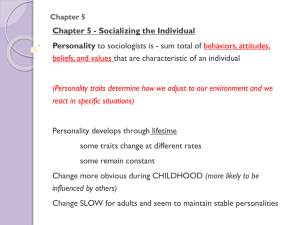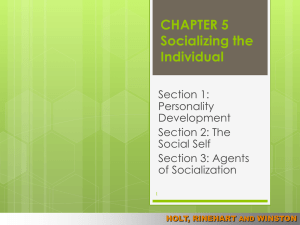Chap5ppt1
advertisement
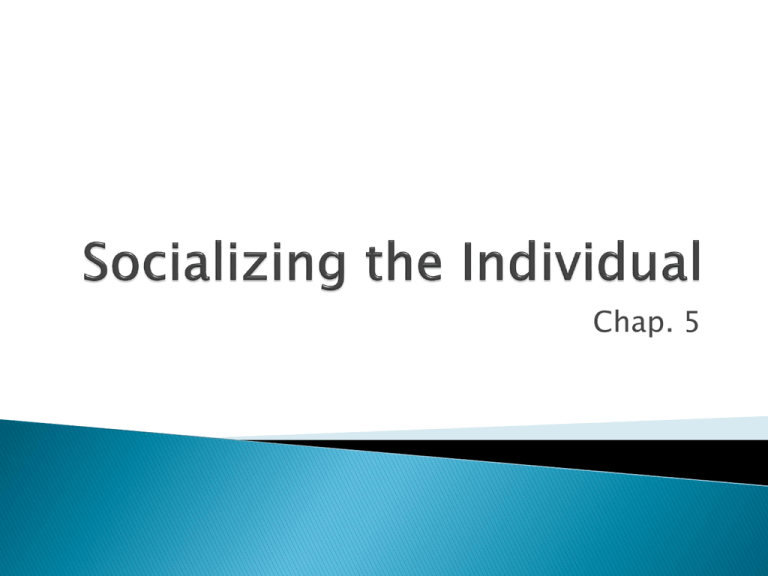
Chap. 5 The sum total of behaviors, attitudes, beliefs and values that are characteristic of an individual Nature vs. Nurture debate The sociobiologist argument: emphasizes the nature point of view. Biology is the basis of all social behavior. HEREDITY is the transmission of genetic characteristics from parents to children. An INSTINCT is biologically inherited trait. The nurture argument is that personality is the result of one’s social environment and learning. Heredity: inherited characteristics, biological drives, limits Parents: parental characteristics Factors that Shape Individual Personality Development Birth order: Number of siblings and order of birth Cultural environment: basic personality types found in a society Some characteristics are present at birth: hair color, eye color, pigment Aptitude is the capacity to learn a particular skill or body of knowledge; music, art Some develop only because of environmental factors such as encouragement; verbal aptitude encouraged by reading to develop innate talent of child Can limit an individual Personality is influenced by birth order Research has shown first born children are more likely to be achievement oriented and responsible than later children, tend to be more conservative in thinking. Later born children are better in social relationships and tend to be more affectionate, more risk taking and social and intellectual rebels Age of parents changes how they relate to children Level of education, religious orientation, economic status, cultural heritage, and occupational background American traits of competitiveness, individualism affect American children Boys and girls experience different cultures affecting development Ethnicity of family Neighborhood-rural vs. urban, regional differences Book case studies prove need for social interaction for development Anna kept alone in isolation Isabelle kept alone with mother Genie never develops Institutionalization further proves need for caring environment for development. Necessary for forming attachments. How does a person’s sense of self emerge? The interactive process through which people learn the basic skills, values, beliefs and behavior patterns of a society is called SOCIALIZATION Your SELF is your conscious awareness of possessing a distinct identity that separates you and your environment from other members of society. John Locke, English philosopher, insisted that each newly born human being is a tabula rasa, or blank slate, on which anything can be written We acquire our personalities as we develop Socialization is a process by which individuals absorb the aspects of their culture with which they come in contact Charles Horton Cooley, an interactionist The interactive process by which we develop an image of ourselves based on how we imagine we appear to others. Three step process: 1.we imagine how we appear to others 2.based on their reactions to us, we determine whether others view us as we view ourselves 3.we use our perceptions of how others judge us to develop feelings about ourselves. George Herbert Mead, interactionist Seeing ourselves as others do is only the beginning Eventually we begin to take on the roles of others. Allows us to anticipate what others expect of us. 1. we internalize the expectations of those closest to us (significant others) 2.expectations of society guide behavior 3. we have internalized self and the generalized other Name Process of Socialization Theory John Locke The Tabula Rasa: Each person is a blank slate at birth, with no personality. People develop personality as a result of their social experiences. Moreover, infants can be molded into any type of person. Charles Horton Cooley The Looking-Glass Self: Infants have no sense of person or place. Children develop an image of themselves based on how others see them. Other people act as a mirror, reflecting back the image a child projects through their reactions to the child’s behavior. George Herbert Mead Role-Taking: People not only come to see themselves as others see them, but also take on or pretend to take on the roles of others through imitation, play, and games. This process enables people to anticipate what others expect of them. Born with no sense of self, begins development about age 3 Begin to play role games, attempt to see world through other’s eyes Organized games come later where have to anticipate actions of others Self consists of the “I” the unsocialized, spontaneous, self-interested component of personality, and the “ME”- the part which is aware of the expectations and attitudes of society-the socialized self. Specific individuals, groups, and institutions that enable socialization to take place The most important agent in every society. Principle socializer or young children. Where learn values, norms, and beliefs of the society and pattern for future interactions. Can be deliberate or unintended. Be polite vs. watch behavior of parents. Not all families the same, members of subgroups influence, large cultural patterns with individual differences Primary group of individuals about the same age and similar social characteristics. Particularly influential pre-teen and teen years. Very influenced by the looking glass self concept, want to fit in. Often values at odds with the larger culture, parents become alarmed if these values seem to become more important than family or larger cultural norms. Mandatory school attendance. Much of this socialization is deliberate, teaching reading, civics, responsibility. Unintentional socialization plays great part of school day with role models and peer groups. No face to face interaction but still strong cultural influence. Books, films, magazines, the internet, radio, tv, music. 98% American homes have TVs, average child watches 28 hours a week. Average American child spends almost twice as much time watching TV as they spend in school. Lots of research examining the effects of TV. By age 18, children will have witnessed 200,000 fictional acts of violence, including 16,000 murders. Does this encourage violence? Image of white, middle class America, with these values predominant. Educational tool-expand world and culture. A TOTAL INSTITUTION is a setting in which people are isolated from the rest of society for a set period of time and are subject to tight control. Prisons, military boot camp, monasteries, mental hospitals Resocialization involves a break from past experiences and learning new norms and values Weaken individual identity in order to rebuild it.



